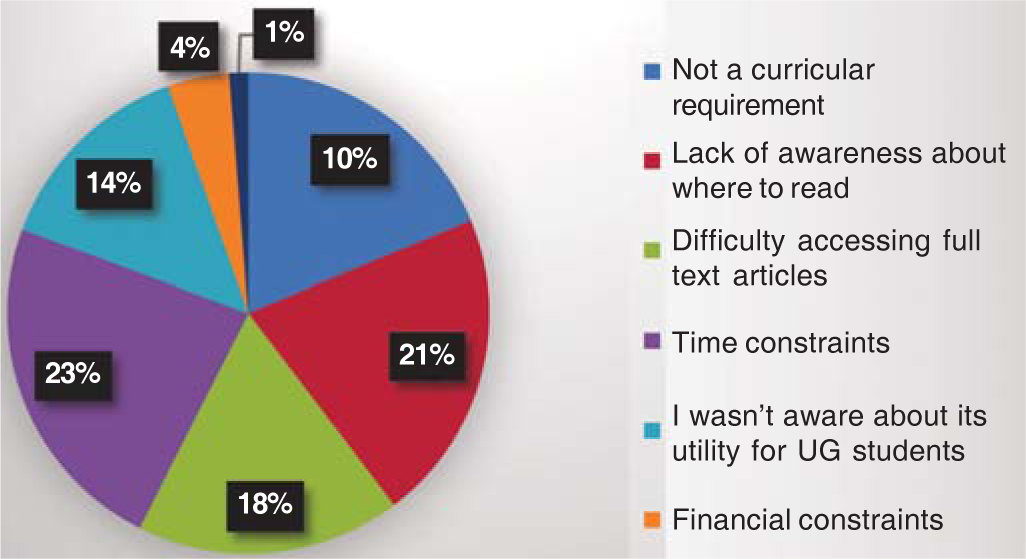Translate this page into:
Journal-reading practices among Indian undergraduate medical students
[To cite: Mittal M, Tyagi V, Maroo BR, Dabas A, Mantan M. Journal-reading practices among Indian undergraduate medical students (Correspondence). Natl Med J India 2024:37:118–19. DOI: 10.25259/NMJI_988_2023]
Early exploration of the primary literature is crucial in engaging students in an enquiry-based, self-directed learning that enhances critical thinking skills.1 Journal-reading also helps students gain self-confidence, communication skills and develop an interest in medical innovations.2,3 We aimed to establish the current journal-reading trends to identify areas of innovation in medical education pedagogy to promote and cultivate a habit of journal-reading among medical undergraduate students.
We did this cross-sectional study over a period of 3 months (June– August 2022) after approval from the institutional ethics committee. Participants were undergraduate medical students from various medical colleges in India. Informed consent was taken before recording their response. Snowball and purposive sampling techniques were used. A self-designed online eight-item questionnaire (open- and close-ended questions) was prepared in English and validated by two experts not related to the study. The Likert scale (1 to 5) was used to record their interests, difficulties in reading scientific literature, and their perceived importance of research articles on academic and scientific development.
The responses received on Google Forms were extracted and compiled in Microsoft Excel; percentages and frequencies were calculated for categorical variables.
A total of 141 undergraduate medical students (61 men, 43.2%) with a mean age (SD) of 20.23 (1.32) years responded. The year-wise distribution was 22 (15.6%) in the first year, 78 (55.3%) in second year, 19 (13.4%) in third year, 15 (10.6%) in final year, and 7 (4.9%) in internship, respectively. The majority, 107 (75.9%) students had no prior research experience, and 119 (84.4%) had no experience in writing a scientific article. Thirty-three (23%) students had never read a research article. Most students, 60 (42.2%) preferred an online view of the journal, 54 (38%) preferred the hardcopy format and 27 (19%) a mobile view.
Among the given specialties of journals, 196 (41.7%) responses indicated interest in basic sciences, laboratory research and genomics, 138 (29.3%) in technology and 136 (28.9%) in public health. The most commonly used medical data sources were Pubmed followed by Google Scholar (Table I). Figure 1 shows the reasons why the students did not read journals. The student’s suggested approaches for journal-reading were (i) institutional access to journals; (ii) tutorials/journal club discussions; (iii) journal-reading workshops for students; (iv) appraising students about relevant articles after classroom teaching; and (v) appreciation/recognition to students who read journals.
| Issue | Strongly disagree | Disagree | Neutral | Agree | Strongly agree |
|---|---|---|---|---|---|
| Invoke interest in the subject | 4 (2.8) | 5 (3.5) | 17 (12) | 89 (63.1) | 25 (17.7) |
| Valuable addition to medical studies | 3 (2.1) | 5 (3.5) | 17 (12) | 92 (65.2) | 24 (17) |
| Staying updated | 2 (1.4) | 1 (0.7) | 15 (10.6) | 89 (63.1) | 32 (22.7) |
| Useful only for research purposes | 26 (18.4) | 69 (49) | 34 (24.1) | 11 (7.8) | 1 (0.7) |
| Should be part of medical curriculum | 1 (0.7) | 5 (3.5) | 24 (17) | 71 (50.4) | 40 (28.4) |
| Difficult and daunting process | 2 (1.4) | 26 (18.4) | 51 (36.2) | 54 (38.3) | 8 (5.7) |
| Institution/faculty cultivates a research environment | 18 (12.7) | 34 (23.9) | 48 (33.8) | 36 (25.3) | 5 (3.5) |
Values in parentheses are percentages Likert scale scored from 1 to 5 as Strongly disagree to Strongly agree
We explored the journal-reading attitude and constraints of undergraduate medical students from different medical colleges in India. A few suggestions that emerged for improving journal-reading behaviour were improved institutional support, training workshops and journal club activities.

- Limitations to journal reading
The heterogeneity of the respondents and small sample size was a perceived limitation. The earlier exposure to journals could have also been variable across different colleges. Most students in first and second year were not exposed to regular college or library facilities due to lockdown in preceding years, which could have resulted in poorer awareness of journals.
Most medical undergraduate students agreed that reading scientific papers invoked interest in the subject and helped them stay updated, similar to earlier studies.3,4 Journal-reading was practised poorly and superficially by students in this study, similar to other studies.5 Our study highlights the need to inculcate the culture of research and evidence-based medicine into medical education.6 Focused journal club discussions and appraising students about articles relevant to their curriculum or interest (such as genomics, technology) may promote journal-reading habit, as suggested in earlier studies.6,7
To conclude, there was a felt need among undergraduate students to read scientific articles and participate in research. Faculty and institutions will be the key stakeholders to initiate these activities to help achieve attributes of self-directed learning and life-long learning in medical students.
References
- Using primary literature to teach science literacy to introductory biology students. J Microbiol Biol Educ. 2013;14:66-77.
- [CrossRef] [PubMed] [Google Scholar]
- Investigations of protein structure and function using the scientific literature: An assignment for an undergraduate cell physiology course. Cell Biol Educ. 2003;2:248-55.
- [CrossRef] [PubMed] [Google Scholar]
- Learning how scientists work: Experiential research projects to promote cell biology learning and scientific process skills. Cell Biol Educ. 2002;1:154-72.
- [CrossRef] [PubMed] [Google Scholar]
- Involvement of medical students and fresh medical graduates of Karachi, Pakistan in research. J Pak Med Assoc. 2011;61:115-20.
- [Google Scholar]
- Reading habits and preferences of year 1-4 medical students in the mobile-device era. Educ Prim Care. 2018;29:310-11.
- [CrossRef] [PubMed] [Google Scholar]
- A.S.P.I.R.E: A student led initiative to foster a facilitative environment for undergraduate medical research. Pers Clin Res. 2022;13:65-69.
- [CrossRef] [PubMed] [Google Scholar]
- Journal-reading habits of undergraduate medical students. Natl Med J India. 2015;28:105.
- [Google Scholar]




